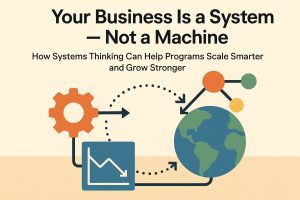
How Systems Thinking Can Help Programs Scale Smarter and Grow Stronger
In the world of entrepreneurship and innovation, we’re often taught to think in funnels, dashboards, and KPIs.
But what if this thinking is too narrow?
What if the reason many incubators, accelerators, and startups struggle isn’t because of bad execution — but because they’re looking at the wrong map?
That’s where Systems Thinking comes in. It’s a mindset shift that helps leaders and program builders understand the interconnected nature of everything around them — and use that awareness to build smarter, more sustainable ventures.
The Problem: Optimization Without Context
Startups and support programs often aim to optimize — more users, better retention, higher investment rounds. But these goals can fall apart quickly when decisions are made without understanding the larger system.
For example:
- A startup expands to a new market without considering local infrastructure or cultural nuances.
- An accelerator adds a new service without checking if it overlaps with what another ecosystem player already offers.
- A university launches a fund for student startups without aligning it with existing national innovation policies.
Each of these reflects a lack of systems thinking. The result? Wasted resources, broken partnerships, or missed opportunities.
So, What Is Systems Thinking?
Systems Thinking is the practice of viewing your business, program, or venture as part of a broader, dynamic ecosystem.
It’s about recognizing:
- Interdependencies: Your actions affect — and are affected by — others.
- Feedback loops: Changes don’t create isolated results — they ripple across the system.
- Time delays: The effect of a decision might take months (or years) to fully appear.
- Leverage points: Small, smart changes in the right place can yield outsized impact.
In simple terms, Systems Thinking asks:
“How does this connect with everything else?”
Before: “What’s the fastest way to grow?”
A Real Example: Scaling Without a System View
Imagine a delivery startup that launches rapidly in a new city. They invest in drivers, marketing, and tech — but soon, growth stalls.
Why?
They didn’t account for:
- Poor road infrastructure
- ⛽Volatile fuel prices
- High driver turnover in that region
- ⚖️Regulatory hurdles on vehicle licensing
They optimized the product, not the system it needed to operate within.
✅ What Happens When You Apply Systems Thinking?
When ecosystem enablers (like incubators or universities) apply Systems Thinking, they unlock benefits like:
- More resilient programsthat adapt to change
- Smarter decision-makingbased on deeper context
- Higher-impact interventionsthanks to better understanding of stakeholder dynamics
- Better alignmentwith local, national, and global trends
At Growthlabs, we’ve seen this firsthand. Programs that map their ecosystem before designing interventions tend to create stronger partnerships, higher startup success rates, and clearer paths to sustainability.
4 Steps to Start Thinking in Systems
Whether you’re running a startup, accelerator, or entrepreneurship center — here’s how to begin:
1. Map Your Ecosystem
Identify all the players: startups, funders, government, talent, regulators, tech providers, etc.
2. Spot the Loops
Look for patterns, feedback loops, and interdependencies. Example: Does better mentorship → better fundraising → stronger alumni → more mentors?
3. Zoom Out Before You Zoom In
Always ask: What bigger system created this challenge?
Sometimes fixing a team issue means redesigning a process, not blaming people.
4. Train Your Team
Embed systems thinking into your operations. Use tools like system maps, scenario planning, or causal loop diagrams.
Final Thought
Your business or program is not a linear pipeline — it’s a living system.
And it operates within other systems: the economy, the education sector, public policy, the environment, and beyond.
The more you understand these systems, the less time you’ll spend reacting — and the more impact you’ll create through intentional design.
At Growthlabs, we build tools that help entrepreneurship programs see the full picture. From assessment frameworks to system-wide analytics — we empower you to lead with clarity, context, and confidence.
Let’s stop managing parts — and start designing for the whole.
Because the future doesn’t belong to the most optimized business…
It belongs to the most adaptive system.
